The Problem
The primary challenge in converting underground areas into useful spaces is how to deal with moisture; how to keep water out from the building without causing long-term damages to the building fabric.
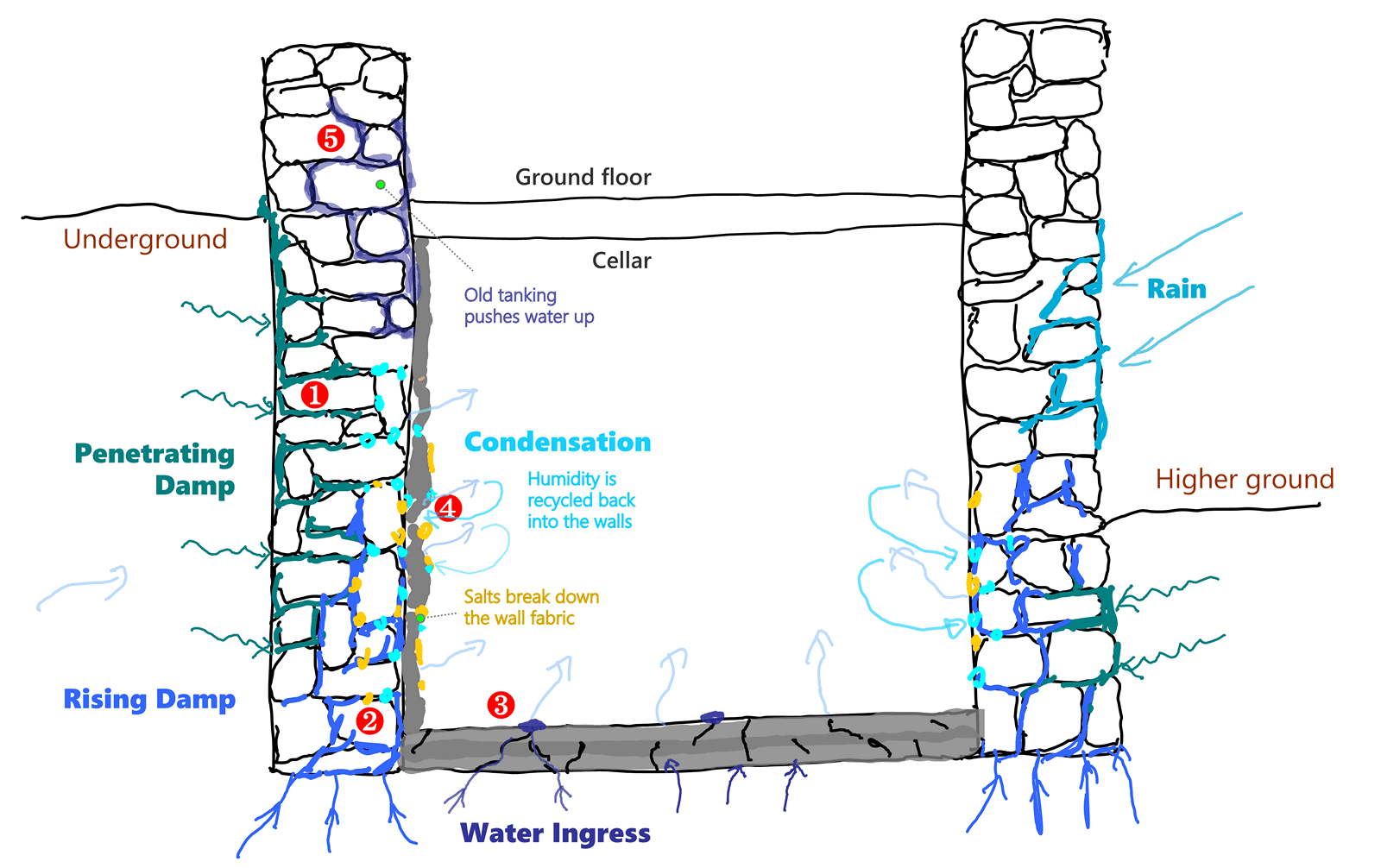
Typical basement problems
The main moisture sources affecting cellars and basements are:
- Penetrating dampness: being underground, cellar walls are in permanent contact with the damp soil. Water penetrates the wall fabric causing either liquid water penetration or ongoing evaporation on the inner face of the walls.
- Rising damp: old walls underground are also subject to rising dampness and salts from the ground.
- Water ingress: aging, dampness and ongoing salt crystallization break down the pointing and the building fabric, making old basements susceptible to water ingress and leaks.
- Condensation (and often mould): constant evaporation from the walls and floor [1, 2 & 3] results in high air humidity. This humidity – assisted by the hygroscopic effect of salts and inadequate ventilation – is recycled back into the walls, resulting in condensation.
- Dampness caused by incorrect past renovations (e.g. old tanking): renovating old cellars with non-breathable materials (cement pointing, tanking, impermeable membranes etc.) makes moisture accumulate behind them, water often being “pushed up” in the building, creating further dampness problems.
Making cellars and basement watertight consists of addressing all of these points, one by one.
Common Basement Waterproofing Solutions
Usually, the dominating moisture source in a basement is sideways moisture penetration due to the presence of the soil and rainwater at the other side of the wall. The penetrating dampness problem can be solved in several ways:
1. Barrier Protection or Tanking
Barrier protection, tanking or Type-A waterproofing provides protection against ground water ingress by applying a waterproofing material (e.g. cementitious slurry, flexible waterproofing membrane (bitumen, rubber), bentonite clay liner etc.) to either the external and/or internal surface of the walls or floors. Once the waterproofing material hardens it makes the walls watertight on a permanent basis.

Tanking a basement
If the waterproof barrier is applied from outside, the water is stopped at the outer face of the walls, allowing the walls to dry if the internal surface is left breathable. The installation of external barriers involves excavation, which is not always possible due to environmental constraints, limiting the options to a drained protection.
2. Drained Protection or Membrane Waterproofing
Drained protection or Type-C waterproofing is applied when liquid water penetration is present. It involves some sort of cavity drain membrane and sump pump combination to drain out liquid moisture. The penetrating ground is then from behind the studded cavity drain membranes via designated drainage channels, being routed to a sump pump for disposal.
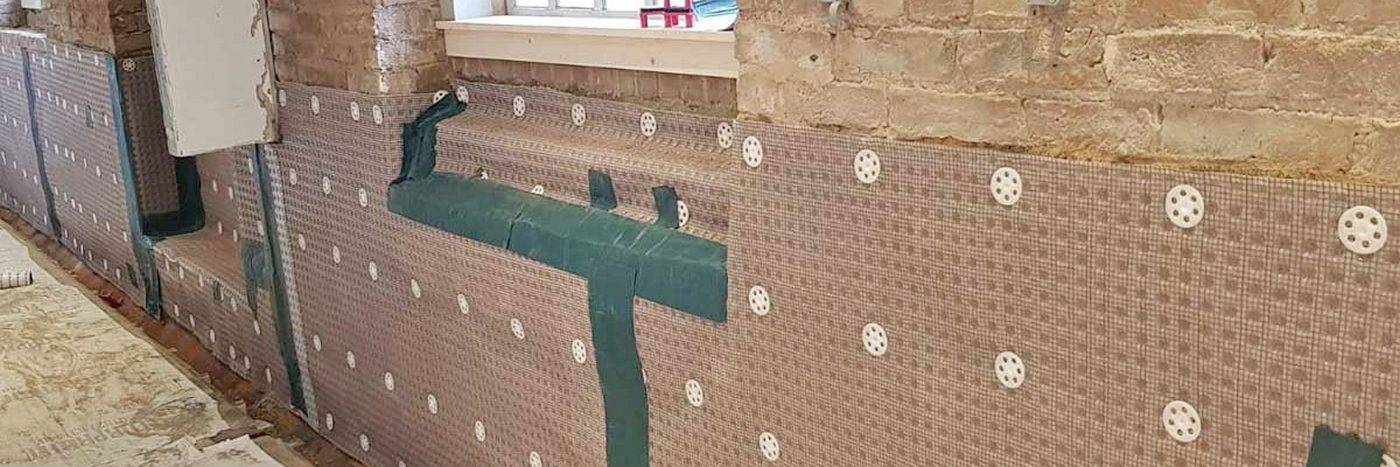
Membrane waterproofing
Old Buildings Require a Different Approach
Most waterproofing solutions on the marketplace have been developed for newer buildings. As described earlier, they use modern waterproofing materials – cement, tar, plastic membranes etc. – that can block water, but they are non-breathable, trap humidity which can lead to the accumulation of moisture behind the waterproofing layer, damaging the fabric of old, historic buildings long-term.
Because the fabric of older buildings often contains a significant amount of moisture (kept in check by ongoing natural evaporation), the materials used for the renovation of these buildings must permit evaporation, i.e. must be breathable.
Many traditional materials – such as regular lime plasters – that can last for decades in a damp-free environment, deteriorate quickly in the presence of elevated humidity and crystallizing salts, thus not being suitable nor long-lasting enough for the waterproofing of old cellars.
The Right Solution for Old Buildings
The ideal waterproofing material for cellars of old and listed buildings would be a lime plaster that could satisfy the following, somewhat contradictory, requirements:
- Be waterproof: to completely stop liquid water in order to keep underground areas dry.
- Breathable: to let water vapours pass through freely to prevent the accumulation of moisture.
- Resistant to salts: salts are the primary reason behind the premature breakdown of lime plasters. A good lime plaster should be able to cope with all salts without being damaged by them.
- Not too hard: so it won’t damage the underlying softer building fabric but mechanically resistant enough to withstand water pressure and the effect of salts.
- Long lasting: have a long service life.
All these points can be achieved with a traditional lime plaster of which origins stretch back to ancient Rome. Being outstanding architects and builders, the Romans have discovered that by adding certain volcanic soils and other minerals to lime, they can significantly alter its properties, including its mechanical strength and water resistance, while retaining its breathability.
The materials most commonly added to lime were natural pozzolans (volcanic soils or rock fragments) and cocciopesto (milled bricks or terracotta fragments). These reacted chemically with the free lime, forming water resistant compounds. Such mortars were able to harden quicker not only in the presence of water but even underwater in the total absence of air, and they are known as hydraulic mortars (water limes).
These traditional pozzolanic Roman mortars differ significantly from today’s NHL (Natural hydraulic lime) mortars. NHL mortars are made of lime and clay. For the clay to react with the lime, the mix must be fired at higher temperatures (at about 1200 °C) than lime alone (which is fired at around 850-900 °C). The higher temperatures close off some of the pores, making the NHL plasters less breathable than normal limes. Thus, NHL plasters trade breathability for improved water resistance.
Natural pozzolanic lime mortars are made of lime and volcanic ashes / sands. Because the volcanic ingredients have already been pre-burned by the volcano, these are incredibly breathable and they readily react with the lime at low firing temperatures (850-900 °C), resulting in a very breathable final product.

Natural volcanic pozzolans have a highly porous, breathable pore structure.
Various volcanic lime mortars have been extensively used by the Romans in very demanding environments including sewers, ports, spas and aqueducts and they have survived for many centuries. They have also been widely used in Venice, well suited to the humid and aggressive environment of the Venetian lagoon.
Plastering Schedule
For the waterproofing of old cellars in a building-friendly way the application of the following plaster coats are recommended:
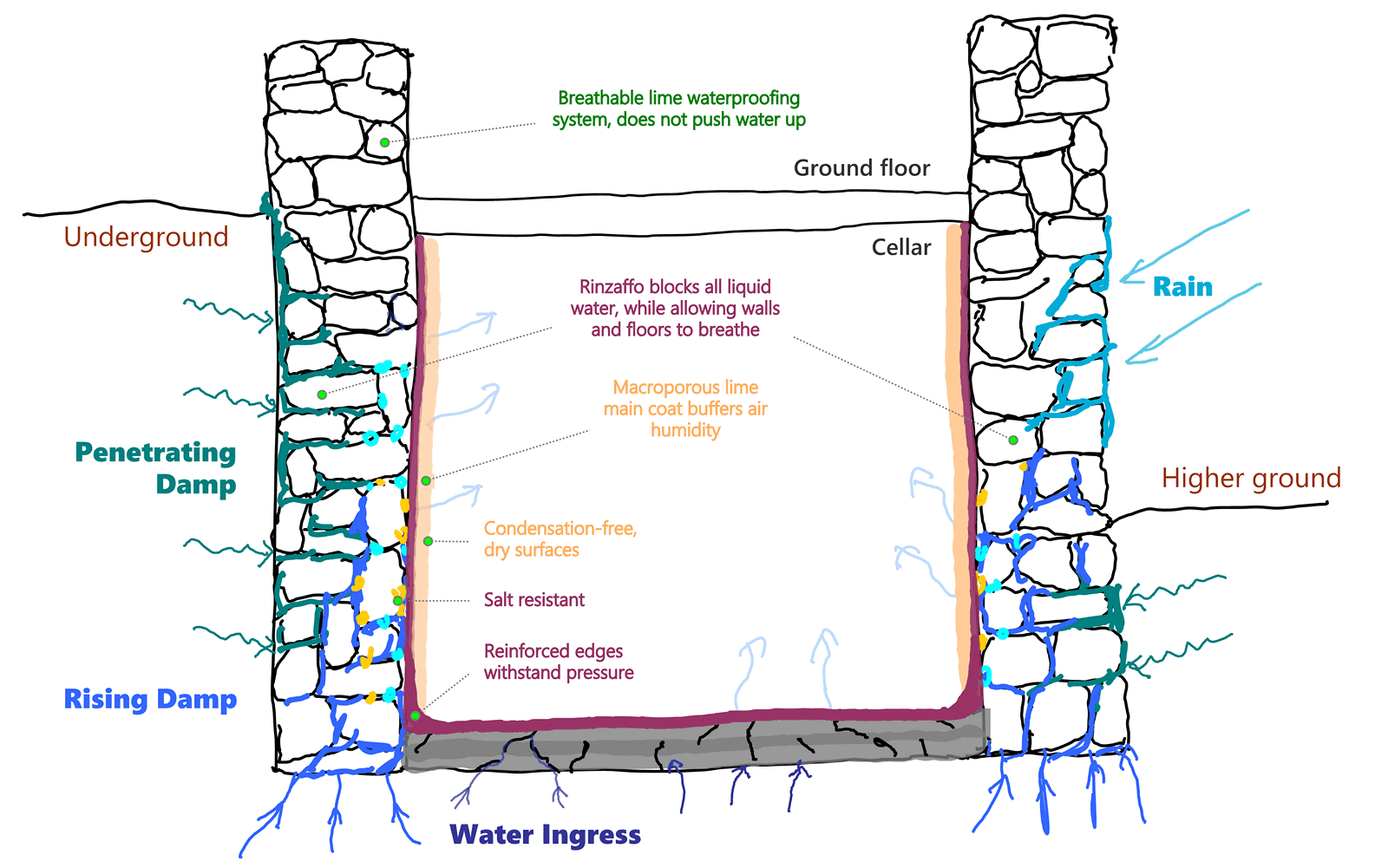
Waterproofing old cellars with lime
1. Roman Lime Waterproofing Base Coat
Rinzaffo MGN is a microporous breathable lime waterproof and salt-resistant base coat. Its main role is to keep liquid water out of the basement to keep the walls dry.
Rinzaffo MGN’s internal pore structural is formulated to stop (larger) liquid water molecules, while letting (smaller) water vapours molecules through, facilitating evaporation. This also prevents the accumulation of vapor pressure behind the waterproofing coat, which plays an important role in the detachment of non-breathable (e.g. cement) plasters.
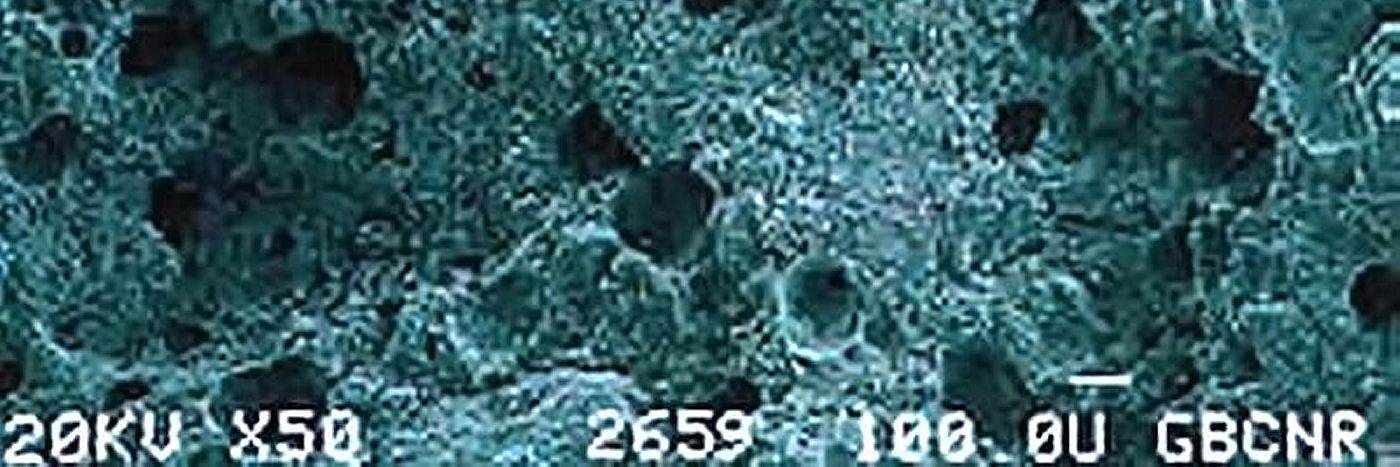
Rinzaffo MGN lime plaster pore structure under the microscope
The application of the Rinzaffo MGN lime plaster alone makes cellars and basements waterproof, resulting in dry surfaces suitable for storage. Adequate ventilation (e.g. extractor fan) must be put in place to ensure the discharge of water vapours.
For the waterproofing of basements or underground areas two coats of Rinzaffo MGN plaster must be applied, each in about 10 mm thickness, resulting in not less than 20 mm lime waterproofing material (lime tanking). Uneven walls can take up more material, which must be calculated with. Embedding a fibreglass reinforcement mesh between the plaster coats is also recommended - a standard practice in plastering.
The plaster can also be applied on floors, making "leaky" floors waterproof and dry. The floor must have enough structural rigidity so it can be made waterproof (e.g. an old concrete floor in decent condition).
The solution can also withstand significant water pressure including hydrostatic pressure. If the base coat is applied on both walls and floors, forming a seamless coat, it can also withstand increased water table or flooding.
If applied correctly, this lime waterproofing solution can last 50 years or longer, significantly longer then modern cement tanking slurries or membranes, while also being breathable and heritage-friendly.
2. Lime Main Coat
Although the Rinzaffo MGN Roman waterproofing base coat can be left as-is in a basement, without any further decoration, most of the time is followed by a main decorative lime coat, There are several reasons for this:
- The colour of the Rinzaffo MGN base coat is brown due to the added volcanic ashes and sands. If someone prefers a white wall, a decorative white lime coat must be applied on top.
- The microporous Rinzaffo MGN plaster is breathable, so water vapours from the underground damp walls are constantly evaporating through its pores. Applying a porous lime plaster on top helps spreading the evaporating humidity from the wall.
- A common question we get is whether the Rinzaffo MGN base coat can be just painted. Yes, it could take a breathable paint, but it has not been designed to be painted. A main lime coat should be applied first, which then can be painted.
The main plaster coat is recommended to be a good quality lime plaster or a thermal insulating lime plaster. Non-breathable plasters, such as modern cement or gypsum plasters should be entirely avoided and should not be applied on top of the Rinzaffo MGN lime base coat.
A recommended decorating coat that performs extremely well in basements or humid environments is a Cocciopesto based plaster. This is an ancient Roman lime plaster used since about 500 B.C. traditionally made of pure slaked lime mixed with crushed tile or brick powder. Its excellent breathability and moisture-regulating properties makes Cocciopesto plasters ideal for the restoration of damp walls. It is also extremely nice and pleasing plaster aesthetically.
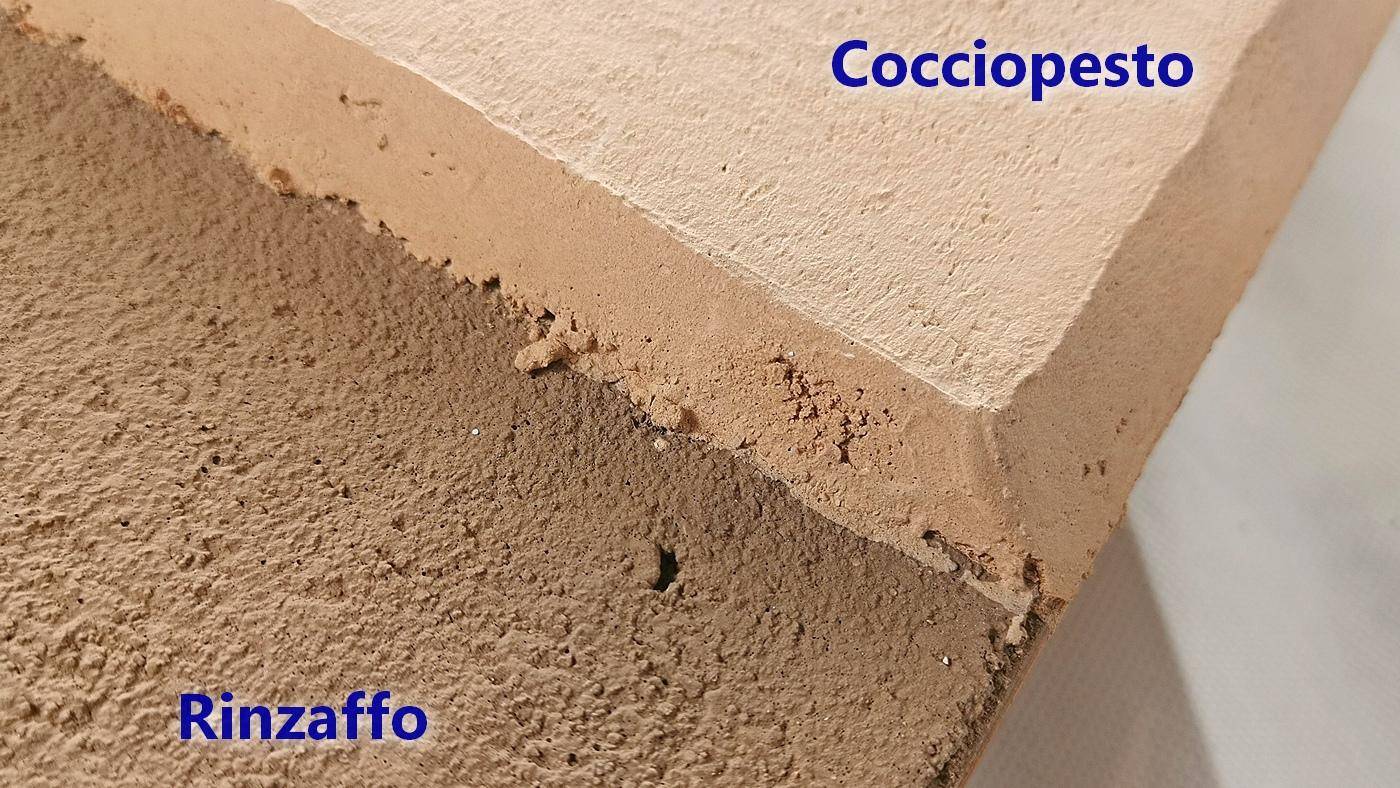
Rinzaffo MGN base and Cocciopesto MGN main plaster
Materials Used
Here is a list of materials that can be used in the Roman lime waterproofing system.
For walls with no need for thermal insulation:
- Rinzaffo MGN – Salt Resistant Protective Lime Base Coat
- Calcina Bianca MGN –Non-thermal white main lime coat
- Calcina Fine MGN – High Quality Fine Lime Finish
For walls in need for thermal insulation:
- Rinzaffo MGN – Salt Resistant Protective Lime Base Coat
- Termointonaco 2020 MGN – High Performance Lime Thermal Insulation Plaster
- TermoRasante AeroGel MGN – Lime-Aerogel Superinsulating Lime Plaster
- Rasante B40 MGN – Protective-Decorative Lime Finish
Other Influencing Factors
Because cellars are usually affected by several moisture sources, the following factors also must be taken into account and if needed, any irregularities rectified, if possible.
- Drainage: the presence of drainage is very important for cellar projects. After all, it's easier and less costly to channel away the water as much water as possible from the building than to fight it. In lack of proper drainage, rainwater doesn't flow away but tends to pool around the basement walls, resulting in a more abundant sideways moisture penetration. Seasonal high water table problems can also be controlled with adequate drainage, depending on the location and specifics of the building.
- Ventilation: there is a lot of invisible vapour humidity in basements, that needs to be ventilated out.
Thus a working ventilation system is an integral part of a basement conversion project and it should not be overlooked.

